
1.
#Thread on one of the greatest Maharanas - Maharana Sangram Simha - more popularly known as Maharana Sanga
Maharana Sanga defeated the Sultanates multiple times, and united the Hindus to face Mughals.
#Hindutva #History #Rajput #Mewar
#Thread on one of the greatest Maharanas - Maharana Sangram Simha - more popularly known as Maharana Sanga
Maharana Sanga defeated the Sultanates multiple times, and united the Hindus to face Mughals.
#Hindutva #History #Rajput #Mewar

2.
1481, Mar 24: Birth of Maharana Sanga
1508, May 4: Maharana Sanga ascended on Mewar throne.
~1512-13: Maharana Sanga attacked and captured territories of eastern Rajasthan from Sikandar Lodi’s Delhi Sultanate
1481, Mar 24: Birth of Maharana Sanga
1508, May 4: Maharana Sanga ascended on Mewar throne.
~1512-13: Maharana Sanga attacked and captured territories of eastern Rajasthan from Sikandar Lodi’s Delhi Sultanate

3.
1515: Maharana Sanga was a proactive strategist. To expand Mewar's influence into Gujarat, he helped its deposed ruler, Rao Raimal, become ruler again.
Muzaffarid Gujarat Sultan, Muzaffar Shah II sent 2 armies to Idar. Both of them were defeated by Idar's army.
1515: Maharana Sanga was a proactive strategist. To expand Mewar's influence into Gujarat, he helped its deposed ruler, Rao Raimal, become ruler again.
Muzaffarid Gujarat Sultan, Muzaffar Shah II sent 2 armies to Idar. Both of them were defeated by Idar's army.

4.
1516-18: Fearing Medini Rai's commanding influence in Malwa administration, the Khalji Sultan of Malwa (Mahmud II) fled to Gujarat. The Muzaffarids then attacked & captured Malwa capital, Mandu (Mandavgarh) in 1518.
But hearing of the march of Maharana Sanga, Muzaffar fled!

1516-18: Fearing Medini Rai's commanding influence in Malwa administration, the Khalji Sultan of Malwa (Mahmud II) fled to Gujarat. The Muzaffarids then attacked & captured Malwa capital, Mandu (Mandavgarh) in 1518.
But hearing of the march of Maharana Sanga, Muzaffar fled!


5.
1518: Maharana Sanga undertook conquest of E.Rajasthan. He captured Gagron & appointed Medini Rai its chief.
He further defeated the armies of Ibrahim Lodi's Delhi Sultanate twice - at Khatoli, & Bari (near Dholpur)


1518: Maharana Sanga undertook conquest of E.Rajasthan. He captured Gagron & appointed Medini Rai its chief.
He further defeated the armies of Ibrahim Lodi's Delhi Sultanate twice - at Khatoli, & Bari (near Dholpur)

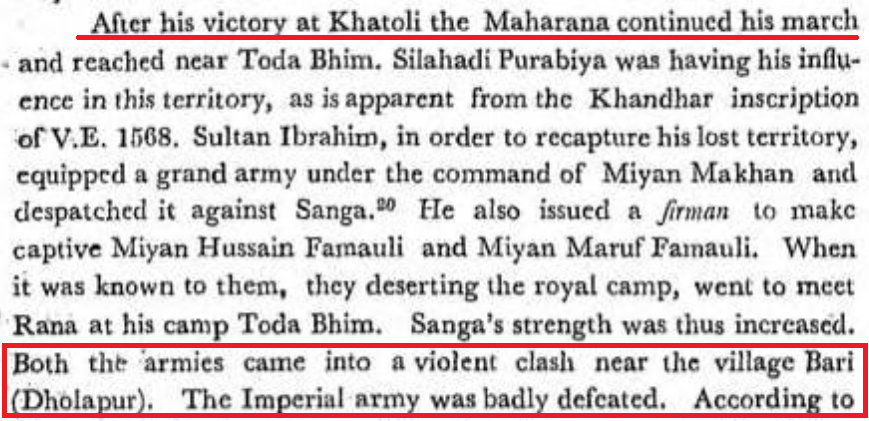

6.
1518-21: Maharana Sanga also defeated the combined armies of Muzaffarid & Khalji Sultanates at Gagron in 1518/9.
But next year, the Muzaffarids provoked Maharana Sanga with an insult. Maharana set off to Idar with 40k cavalry & more infantry.

1518-21: Maharana Sanga also defeated the combined armies of Muzaffarid & Khalji Sultanates at Gagron in 1518/9.
But next year, the Muzaffarids provoked Maharana Sanga with an insult. Maharana set off to Idar with 40k cavalry & more infantry.

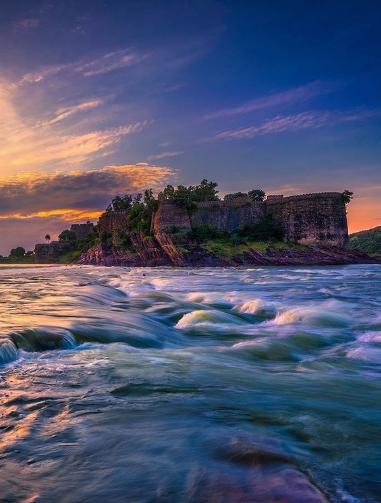
7.
In a *Hindu blitzkrieg*, Maharana won Idar within a day! Muzaffarids fled towards Himmatnagar (~30 kms away); they were besieged & again defeated in battle. Maharana Sanga returned to Mewar after laying waste the Gujarati lands.
Within a week, the Gujarat Sultan was humbled.


In a *Hindu blitzkrieg*, Maharana won Idar within a day! Muzaffarids fled towards Himmatnagar (~30 kms away); they were besieged & again defeated in battle. Maharana Sanga returned to Mewar after laying waste the Gujarati lands.
Within a week, the Gujarat Sultan was humbled.
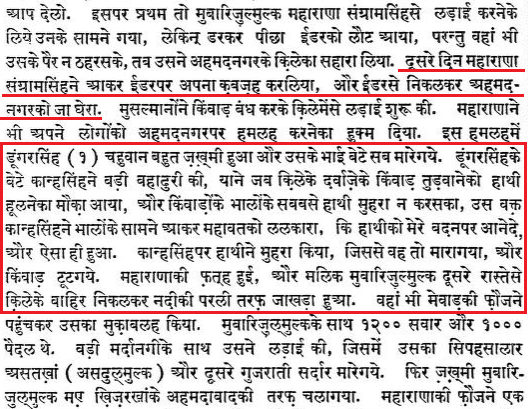

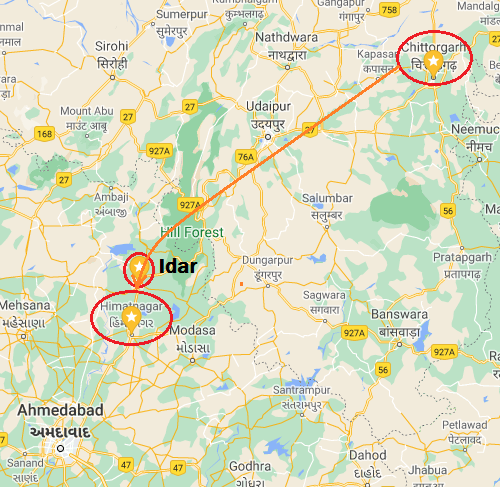
8.
Muzaffar Shah sent 120k cavalry under Malik Ayaz to invade Mewar. They captured Dungarpur, Banswara & besieged Mandsaur fort.
Maharana tactfully isolated Gujarat by dissuading Malwa Sultan from helping Malik (by releasing his hostage son). Malik left the campaign demoralised.



Muzaffar Shah sent 120k cavalry under Malik Ayaz to invade Mewar. They captured Dungarpur, Banswara & besieged Mandsaur fort.
Maharana tactfully isolated Gujarat by dissuading Malwa Sultan from helping Malik (by releasing his hostage son). Malik left the campaign demoralised.




9.
1524-26: This was a period of political changes around Mewar. The Gujarat Sultan's unhappy prince came to Mewar, then went away to Mewat, & Lodi at Delhi. He became Guj Sultan in Feb 1526.
Apr 1526: Babur defeated Ibrahim Lodi at 1st Battle of Panipat to found Mughal rule
1524-26: This was a period of political changes around Mewar. The Gujarat Sultan's unhappy prince came to Mewar, then went away to Mewat, & Lodi at Delhi. He became Guj Sultan in Feb 1526.
Apr 1526: Babur defeated Ibrahim Lodi at 1st Battle of Panipat to found Mughal rule

10.
At the dawn of 1527, Mewar under Maharana Sanga was at its zenith! (Map 👇)
Within a year of Panipat battle, Mughals reached & occupied upto Bayana, very close to Mewar borders.
At the dawn of 1527, Mewar under Maharana Sanga was at its zenith! (Map 👇)
Within a year of Panipat battle, Mughals reached & occupied upto Bayana, very close to Mewar borders.
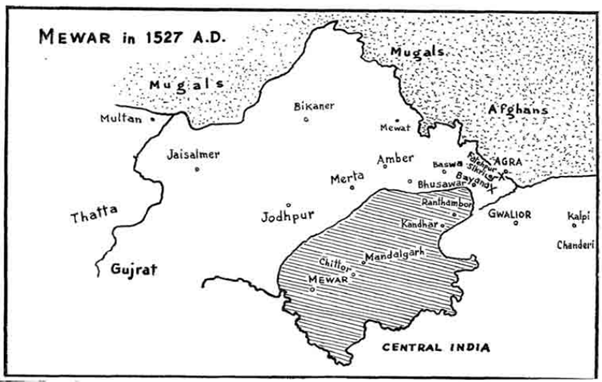
11.
1527, Feb 15-21: The Hindu confederacy, numbering over 2 lakh cavalry & infantry, united under Maharana Sanga.
Several illustrious names appear here, uniting under a banner to fight for the Hindu Dharma - Prithviraj Kachwaha, Medini Rai, etc.

1527, Feb 15-21: The Hindu confederacy, numbering over 2 lakh cavalry & infantry, united under Maharana Sanga.
Several illustrious names appear here, uniting under a banner to fight for the Hindu Dharma - Prithviraj Kachwaha, Medini Rai, etc.
https://twitter.com/HindutvaItihas/status/1419646356885540864


12.
The strong force besieged Bayana. A Mughal army, sent for relief, was also utterly defeated. They fled to Babur’s camp, & their reports to Babur completely demoralised the Mughal generals & army over the next week.
This was the last great triumph of Maharana Sanga's life.


The strong force besieged Bayana. A Mughal army, sent for relief, was also utterly defeated. They fled to Babur’s camp, & their reports to Babur completely demoralised the Mughal generals & army over the next week.
This was the last great triumph of Maharana Sanga's life.


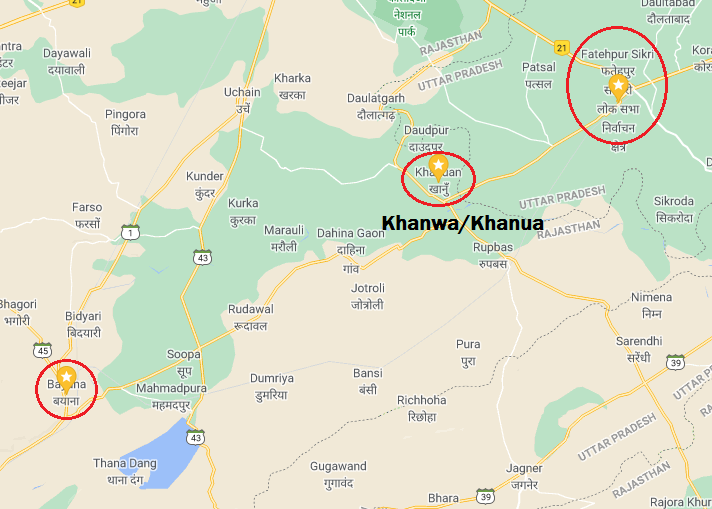
13.
1527, Mar 16: Battle of Khanwa.
Rajputs charged the Mughal wings, but they were stalemated. Musketeer fire from Mughals kept weakening the Hindu centre. Towards the end of battle, Babur brought in his artillery in the centre, which won Babur the battle in the end.
1527, Mar 16: Battle of Khanwa.
Rajputs charged the Mughal wings, but they were stalemated. Musketeer fire from Mughals kept weakening the Hindu centre. Towards the end of battle, Babur brought in his artillery in the centre, which won Babur the battle in the end.

14.
Maharana Sanga was injured in the eye during the battle. He was escorted away from Khanwa by Prithviraj Kachwaha, Rao Maldeo, Rao Akhai Raj Deveda.
1528, May 20: However, Maharana Sanga passed away ~1 year after Khanwa
Maharana Sanga was injured in the eye during the battle. He was escorted away from Khanwa by Prithviraj Kachwaha, Rao Maldeo, Rao Akhai Raj Deveda.
1528, May 20: However, Maharana Sanga passed away ~1 year after Khanwa
15.
Throughout his whole life, Maharana Sanga was victorious against the Sultans of Gujarat, Malwa & Delhi, even a victory against Mughals!
Historians till now have done great harm to the Hindu collective memory by reducing him only to Battle of Khanwa.
Throughout his whole life, Maharana Sanga was victorious against the Sultans of Gujarat, Malwa & Delhi, even a victory against Mughals!
Historians till now have done great harm to the Hindu collective memory by reducing him only to Battle of Khanwa.
16.
Hence, as Hindus, it's our duty to remember, unabashedly celebrate, and get inspired by Maharana Sanga's proactive & courageous life.
Maharana Sangram Simha ki Jai 🙏🚩
#Hindutva #History #Mewar #Rajput
Hence, as Hindus, it's our duty to remember, unabashedly celebrate, and get inspired by Maharana Sanga's proactive & courageous life.
Maharana Sangram Simha ki Jai 🙏🚩
#Hindutva #History #Mewar #Rajput

• • •
Missing some Tweet in this thread? You can try to
force a refresh






















